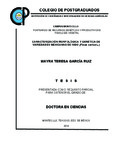Caracterización morfológica y genética de variedades mexicanas de higo (Ficus carica L.)
Abstract
El higo común (Ficus carica L.) fue introducido en México por los misioneros Franciscanos españoles en el siglo XVI, por lo que se asume que los higos mexicanos son de la variedad española Black Mission. Nosotros colectamos y propagamos plantas de higo de seis estados del centro de México. Aquí nosotros presentamos una caracterización morfológica de poblaciones mexicanas de higo, basada en atributos cualitativos y cuantitativos del fruto, así como una metodología estandarizada para la extracción de ADN y un análisis de huellas de ADN, basadas en una combinación de RAPDs, ISSRs y RFLPs. Nuestros resultados muestran una gran diversidad en la morfología del fruto, la que no puede ser explicada únicamente por efecto de las condiciones ambientales. Las principales diferencias entre las poblaciones mexicanas de higo son el tamaño o peso del fruto, el color de la pulpa, la longitud del cuello y la forma del pedúnculo. Las huellas de ADN demuestran de manera contundente que las poblaciones de higo en el centro de México son genéticamente diferentes. Con base en estos resultados, llegamos a la conclusión de que después de cientos de años los higos negros se han adaptado a condiciones ambientales locales en el centro de México, generando variedades claramente distintas que representan diversidad morfológica y genética valuable y previamente no descrita. Aunque México no es el centro de origen del higo, nuestros resultados muestran claramente que México es una fuente de diversidad genética del higo. También sugerimos nombres para las variedades caracterizadas con base en sus lugares de origen y establecemos las bases para la futura caracterización agronómica y molecular de variedades de higo. _______________ MORPHOLOGICAL AND GENETIC CHARACTERIZATION OF MEXICAN FIG (Ficus carica L.) VARIETIES. ABSTRACT: The common fig (Ficus carica L.) was introduced into Mexico by spanish Franciscan missionaries in the 16th century, so that is it assumed that Mexican figs belong to the spanish cultivar Black Mission. We collected and propagated fig plants from six states in the Central Mexico region. Here we present a morphological characterization of Mexican fig populations, based on qualitative and quantitative fruits traits, as well as a standardized method to extract DNA from young leaves, and a DNA fingerprinting analysis based on a combination of RAPDs, ISSRs and RFLPs. Our results show a great diversity in the morphology of the fruit, which can not be explained only by the effects of environmental conditions. The main morphological differences among Mexican fig landraces are the fruit size or weight, color of the pulp, length of the neck and the shape of the stalk. DNA fingerprinting showed in a forceful way that the Mexican fig populations were genetically different among them. Based on these results, we came to the conclusion that after hundreds of years of cultivations, the black figs have been adapted to the local environmental conditions of the center of Mexico, yielding in several clearly distinct landraces, which represent valuable and previously undescribed genetic and morphological diversity. Though Mexico is not the center of origin of the fig, our results show clearly that Mexico is a source of genetic diversity of the fig. We also suggest names for the varieties characterized based on their place of origin and established the basis for further agronomic characterization of fig varieties.
Collections
- Tesis MC, MT, MP y DC [131]


